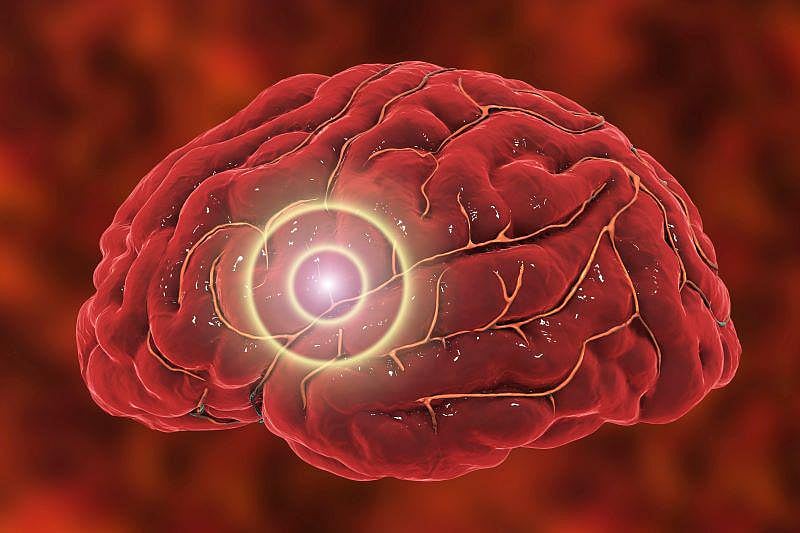Get Healthy!

- Posted May 22, 2023
Scientists Watch Pain in the Brain to Decode Its Secrets
For the first time ever, researchers have recorded specific brain activity associated with real-world chronic pain, using electrode implants to figure out which regions become active when people are in agony.
The results provide further evidence that chronic pain is essentially different from short-term pain, by showing that such pain is processed in a separate region of the brain, said lead researcher Dr. Prasad Shirvalkar, an associate professor of anesthesia with the University of California, San Francisco.
Chronic pain tended to be processed by the orbitofrontal cortex (OFC), a region rarely studied in pain medicine. This region is associated with decision-making, emotion and reward.
On the other hand, short-term pain signals appeared to be managed by the anterior cingulate cortex (ACC), which already has been extensively implicated in the emotional processing of pain.
"It reveals that chronic pain is not just a more enduring version of acute pain. It's actually a fundamentally different interplay with different circuits,"Shirvalkar explained. "The hope is that as we understand this better, we can actually use this information to develop personalized brain stimulation therapies for the most severe forms of pain."
For the study, researchers implanted electrodes into the brains of four people suffering from neuropathic pain, which is caused by damage to the nervous system itself. Three of the people had chronic pain following a stroke, while the fourth had phantom limb pain.
The electrodes specifically targeted the OFC and the ACC, since prior studies had found that both regions light up during acute pain experiments, Shirvalkar said.
"In the past, when people have tried treating chronic pain with brain stimulation, they've really targeted brain circuits focusing on the physical touch dimension, physical pain,"Shirvalkar said. "We thought it's likely that circuits in the brain that represent the emotional parts of pain or even the cognitive parts of pain may be more important for understanding what individual patients are going through."
Several times a day, the participants were asked to rate the pain they were experiencing -- how strong, what type, how it made them feel emotionally.
The patients then clicked a remote-control device that recorded their brain activity for about 30 seconds, providing a snapshot to compare to their self-reported pain, Shirvalkar said.
Using computer analysis, the researchers found that chronic pain tended to rely more on the OFC, causing sustained changes in brain waves there that constitute a biomarker for chronic pain.
Further, they found that they could use activity in the OFC to predict a patient's self-reported chronic pain state.
"We learned that chronic pain can successfully be tracked, can actually successfully be predicted in the real world while patients are walking their dog, while patients are at home, when they get up in the morning, when they're going about their lives,"Shirvalkar said. "We actually developed an objective biomarker for that type of pain."
The researchers also applied heat to areas of the participants' bodies, to track how their brains responded to short-term (acute) pain. In two of the four patients, brain activity could predict pain responses -- but the ACC appeared the region most involved in managing acute pain.
Because these electrodes can also deliver deep brain stimulation, the hope is that researchers can figure out a way to create a "pacemaker"for the brain that modulates oncoming chronic pain, Shirvalkar explained.
"We are recruiting for a clinical trial to try to develop this therapy in patients,"he said. The target is to get six patients for the next trial phase, and then move on to 20 or 30 patients.
It also might be possible to develop a less invasive way to monitor a person's chronic pain, using a wearable device that assesses signals from these brain regions, Shirvalkar noted.
The knowledge gained from this study also might help direct less invasive ways to manage chronic pain, said Dr. Desimir Mijatovic, a pain medicine physician with the Cleveland Clinic, in Ohio.
"There already are some treatments that are being tried, things like transcranial magnetic stimulation, which can actually target these parts of the brain and try to alter the way that they're functioning,"Mijatovic said. "It's an external magnetic signal that gets applied to the brain and tries to change the way the electrical signals are sent. This study maybe can provide more information on how to do it or how to target certain parts of the brain."
The new study, published May 22 in the journal Nature Neuroscience, adds more weight to the understanding that chronic pain acts very differently than acute pain, said Dr. David Dickerson, chair of the American Society of Anesthesiologists' Committee on Pain Medicine.
"Clinically they are very different phenomenon, acute pain being protective and chronic pain being something that's pathologic,"Dickerson said. "Chronic pain is not something that protects us. It's actually our protective machinery going awry. And what we're seeing here is that it's actually even in a different part of the brain."
More information
The Cleveland Clinic has more about chronic pain.
SOURCES: Prasad Shirvalkar, MD, PhD, associate professor, anesthesia, University of California, San Francisco; Desimir Mijatovic, MD, pain medicine physician, Cleveland Clinic, Ohio; David Dickerson, MD, chair, American Society of Anesthesiologists' Committee on Pain Medicine; Nature Neuroscience, May 22, 2023



